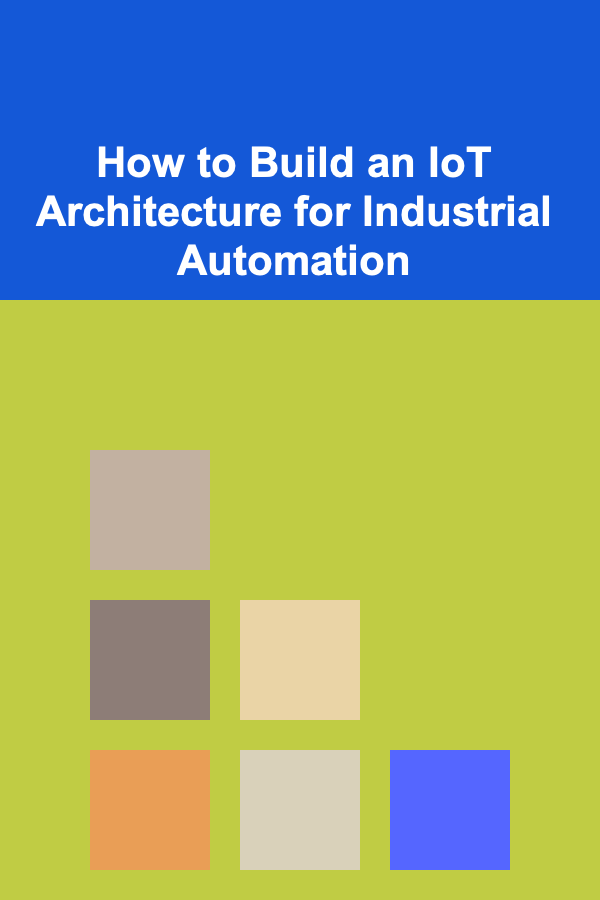
How to Build an IoT Architecture for Industrial Automation
ebook include PDF & Audio bundle (Micro Guide)
$12.99$8.99
Limited Time Offer! Order within the next:

The Internet of Things (IoT) is revolutionizing various industries, especially in the realm of industrial automation. By connecting physical devices and machinery to the internet, businesses can optimize processes, improve efficiency, reduce downtime, and increase overall productivity. An IoT architecture for industrial automation involves a complex integration of hardware, software, networking, and data analytics to enable real-time monitoring, control, and optimization of industrial systems.
In this article, we'll explore how to build a robust IoT architecture for industrial automation. From understanding the foundational components of IoT to implementing advanced analytics, this guide will cover all the steps and considerations necessary to build an efficient and scalable IoT system for the industrial sector.
Understanding the Core Components of IoT Architecture
Before diving into how to design and build an IoT architecture for industrial automation, it's essential to understand the key components involved. An IoT system is composed of multiple layers, each with a specific role in the data flow and overall functionality.
1. Edge Devices
Edge devices are the foundational layer of an IoT system. These devices include sensors, actuators, and industrial machines that collect data and perform tasks on-site. They are responsible for gathering information, such as temperature, pressure, humidity, vibration, and more. Edge devices can be classified into:
- Sensors: These collect data from the environment, such as temperature sensors, pressure gauges, and motion detectors.
- Actuators: Devices that take actions based on the data they receive, such as opening a valve or adjusting the speed of a motor.
- Industrial Equipment: These include machinery, production lines, and robots that are integrated into the system for monitoring and control.
The role of edge devices is crucial as they initiate data capture and control processes, making them the starting point of an IoT-based industrial automation system.
2. Gateways
Gateways act as intermediaries between edge devices and the cloud or central processing unit. They aggregate data from sensors and other edge devices, performing preprocessing tasks like filtering, aggregation, and even initial analysis before transmitting it to the cloud.
Gateways serve several purposes in an IoT architecture:
- Data Transmission: They ensure data flows securely from edge devices to the cloud or on-premises servers.
- Protocol Conversion: Industrial IoT devices often use different communication protocols, such as Modbus, MQTT, or OPC-UA. Gateways translate between these protocols to ensure seamless communication.
- Local Decision Making: Some gateways are equipped with local processing capabilities, enabling basic analytics and decision-making without needing to send data to the cloud.
3. Cloud or On-Premises Infrastructure
Cloud platforms or on-premises data centers provide the necessary infrastructure to store, process, and analyze the data received from edge devices via gateways. This layer serves as the backbone of the IoT system, where high-level analytics, monitoring, and optimization occur.
Key tasks performed at this level include:
- Data Storage: Cloud or on-premises storage systems hold vast amounts of data from sensors and equipment, enabling historical analysis and reporting.
- Data Analytics: Advanced algorithms are applied to the data to derive insights such as predictive maintenance schedules, process optimization, and anomaly detection.
- Visualization and Dashboards: User interfaces allow operators and decision-makers to visualize the data and insights in real-time. Dashboards are critical for monitoring the health of industrial systems and for making informed decisions.
4. Networking and Communication Protocols
The network layer connects all the different components of an IoT architecture, enabling communication between edge devices, gateways, and the cloud. Several communication protocols and networking technologies are employed to ensure reliable and secure data transmission.
Some of the most common protocols in industrial IoT include:
- Wi-Fi: Popular for environments with high-speed internet and low latency.
- Ethernet: Common in industrial environments due to its reliability and speed.
- LoRaWAN (Long Range Wide Area Network): Ideal for low-power, wide-area communications, perfect for large industrial sites.
- 5G: Emerging technology that promises ultra-low latency and high bandwidth, enabling real-time automation.
- MQTT: A lightweight messaging protocol for efficient communication in IoT applications, especially in industrial automation.
Security is also a primary concern in industrial IoT. Implementing secure communication protocols (e.g., TLS/SSL) is essential to protect sensitive data from cyber threats.
5. Data Analytics and AI/ML Layer
Once data is transmitted to the cloud or on-premises infrastructure, it is analyzed to extract valuable insights. This layer uses advanced data analytics techniques and machine learning algorithms to optimize industrial processes.
Analytics tasks include:
- Predictive Maintenance: By analyzing sensor data, machine learning models can predict failures before they occur, reducing downtime and maintenance costs.
- Process Optimization: Analyzing data in real-time helps optimize production processes by adjusting variables such as temperature, speed, and pressure.
- Anomaly Detection: Detecting abnormal behavior in machines or processes helps identify potential issues early, preventing costly failures.
- Energy Management: IoT systems can help monitor energy consumption and identify opportunities for energy savings and efficiency improvements.
Designing an IoT Architecture for Industrial Automation
Now that we've reviewed the core components of an IoT architecture, it's time to dive into how to design and build a scalable and efficient IoT system for industrial automation.
Step 1: Define Your Use Case and Objectives
Before designing the architecture, it's essential to define the problem you are trying to solve. Industrial automation covers a broad range of applications, including predictive maintenance, process optimization, energy management, and quality control. Understanding the specific goals and requirements of the system will help in selecting the appropriate technology stack, sensors, and communication protocols.
Step 2: Select the Right Sensors and Edge Devices
The choice of sensors and edge devices depends on the type of data you need to collect. For instance, if you want to monitor temperature, pressure, or vibration, selecting the right sensors is crucial. Additionally, edge devices must be capable of handling the data and sending it to the gateway or processing unit.
Factors to consider when selecting sensors and edge devices include:
- Data Accuracy: Ensure the sensors can provide precise and reliable data for analysis.
- Environmental Conditions: Industrial environments may have extreme temperatures, humidity, or vibration. Ensure that the devices are rugged and can withstand harsh conditions.
- Power Requirements: Some edge devices may need to be powered continuously, while others may operate on battery power for longer periods.
Step 3: Establish a Secure Communication Network
Design a secure and reliable communication network that connects all the components of the IoT system. Choose the appropriate networking technology and communication protocols based on factors such as range, bandwidth, power consumption, and security.
For industrial automation, reliability and low latency are crucial. Using a combination of wired (Ethernet) and wireless (Wi-Fi, LoRaWAN, or 5G) technologies can ensure continuous and efficient data flow.
Step 4: Implement Data Aggregation and Preprocessing at the Gateway
Gateways serve as the intermediary between edge devices and the cloud or on-premises infrastructure. They collect data from sensors, preprocess it, and forward it to the cloud for further analysis.
Consider implementing basic filtering, aggregation, and data compression at the gateway level. This will reduce the amount of data transmitted and ensure that only relevant information reaches the cloud.
Step 5: Utilize Cloud or On-Premises Infrastructure for Storage and Analytics
The cloud or on-premises infrastructure is the central hub of your IoT system. It should support high-volume data storage, analytics capabilities, and provide real-time processing power. Choose a cloud platform that supports industrial IoT applications or deploy an on-premises solution if your requirements demand more control over data.
Popular cloud platforms for industrial IoT include:
- Microsoft Azure IoT: A comprehensive platform offering various IoT services, including data storage, analytics, and machine learning.
- AWS IoT Core: A scalable platform that integrates with AWS services to provide IoT-specific data storage and analytics capabilities.
- Google Cloud IoT: Provides IoT solutions that include data analytics and machine learning for industrial automation.
Step 6: Apply Machine Learning and Analytics for Optimization
Once the data is collected and stored, the next step is to apply machine learning and advanced analytics techniques to derive actionable insights. Predictive maintenance, process optimization, and anomaly detection can all be achieved using AI/ML algorithms.
Machine learning models can be deployed in the cloud or on edge devices to predict equipment failures, optimize production schedules, and improve overall system efficiency.
Step 7: Design a User-Friendly Interface for Monitoring and Control
The final step in building an IoT architecture is designing a user-friendly interface for monitoring and controlling the system. Dashboards and visualization tools are essential for operators and decision-makers to monitor real-time data and make informed decisions.
Some considerations for building an effective interface include:
- Real-Time Monitoring: Display key performance indicators (KPIs) such as machine health, energy consumption, and production efficiency in real-time.
- Alerts and Notifications: Implement alert systems that notify operators of potential issues or failures.
- Control Capabilities: Allow operators to adjust settings or take corrective actions when necessary.
Conclusion
Building an IoT architecture for industrial automation is a complex but rewarding process. By carefully selecting components, ensuring secure communication, and leveraging advanced analytics and machine learning, industries can unlock the full potential of their automation systems. With the right architecture in place, businesses can achieve greater efficiency, reduced downtime, and enhanced productivity, ultimately staying ahead of the competition in the ever-evolving industrial landscape.
Reading More From Our Other Websites
- [Home Maintenance 101] How to Perform Seasonal Maintenance on Your Home
- [Digital Decluttering Tip 101] Best Password Management Practices for Families with Teens
- [Home Party Planning 101] How to Plan the Perfect Outdoor Home Party for Any Season
- [Personal Care Tips 101] How to Avoid Plateaus in Your Workout Routine
- [Tiny Home Living Tip 101] Best DIY Storage Hacks for Tiny Home Owners with Limited Space
- [Home Rental Property 101] How to Make Your Rental Property Stand Out from the Competition
- [Biking 101] Essential Bike Parts Every Cyclist Should Know About
- [Organization Tip 101] How to Design an Organized and Functional Mudroom
- [Simple Life Tip 101] Best Strategies for Simplifying Holiday Shopping and Gift Giving
- [Organization Tip 101] How to Create a Master Document List for Your Files

How to Clean and Maintain Your Refrigerator to Prevent Breakdowns
Read More
How to Meal Prep for Sustainable Weight Loss
Read More
How to Store Your Outdoor Gear in Small Apartments
Read More
How to Use Job Alerts Effectively: Set It and Forget It
Read More
The Digital Marketing Manager's Guide to Success
Read More
How to Eat Healthy on a Road Trip
Read MoreOther Products

How to Clean and Maintain Your Refrigerator to Prevent Breakdowns
Read More
How to Meal Prep for Sustainable Weight Loss
Read More
How to Store Your Outdoor Gear in Small Apartments
Read More
How to Use Job Alerts Effectively: Set It and Forget It
Read More
The Digital Marketing Manager's Guide to Success
Read More